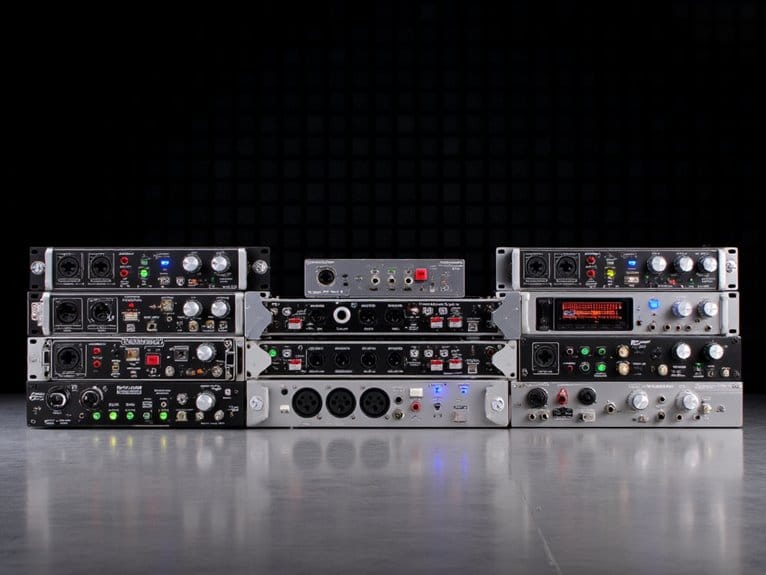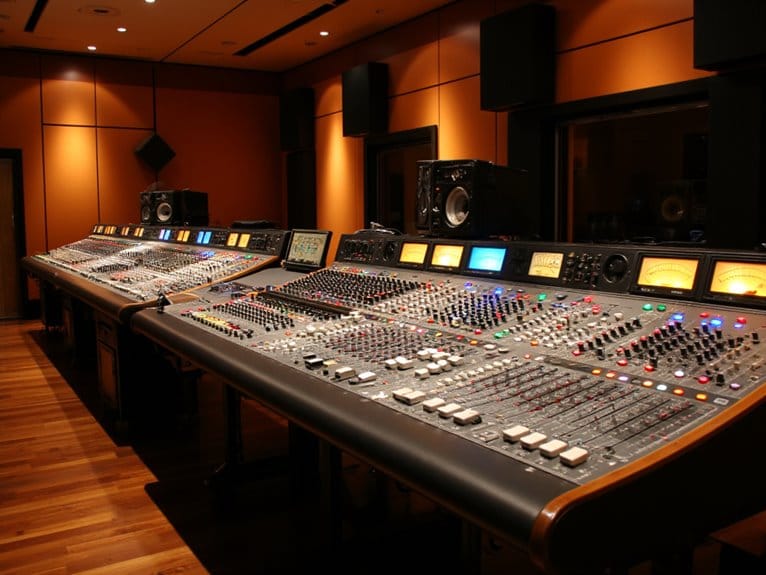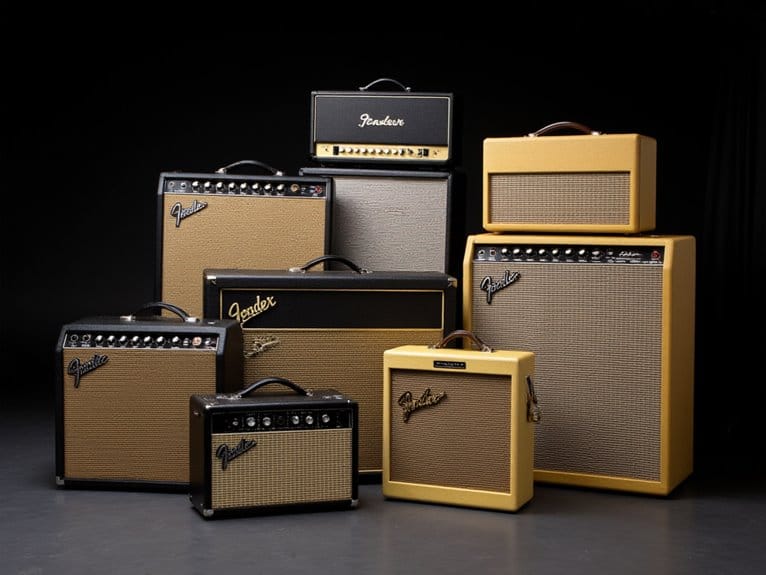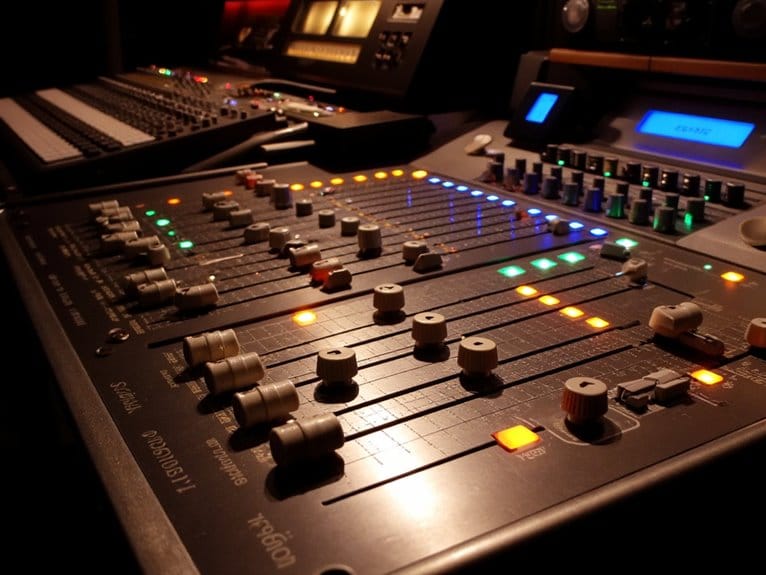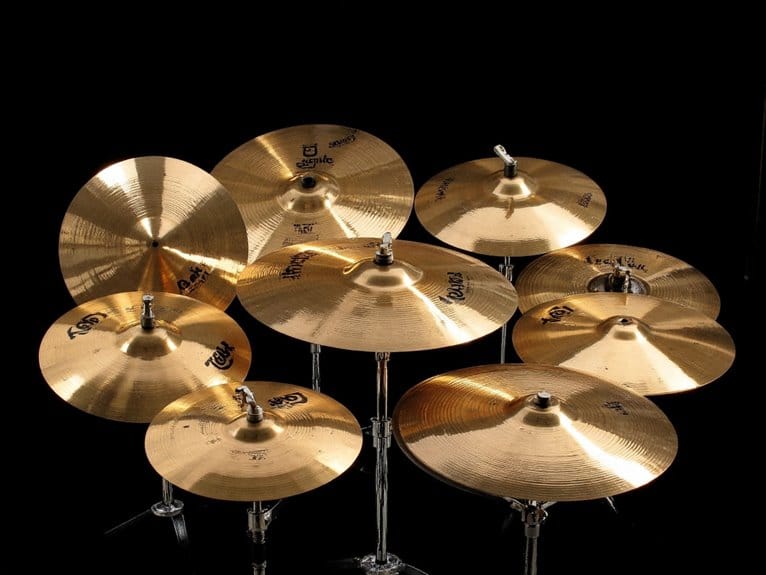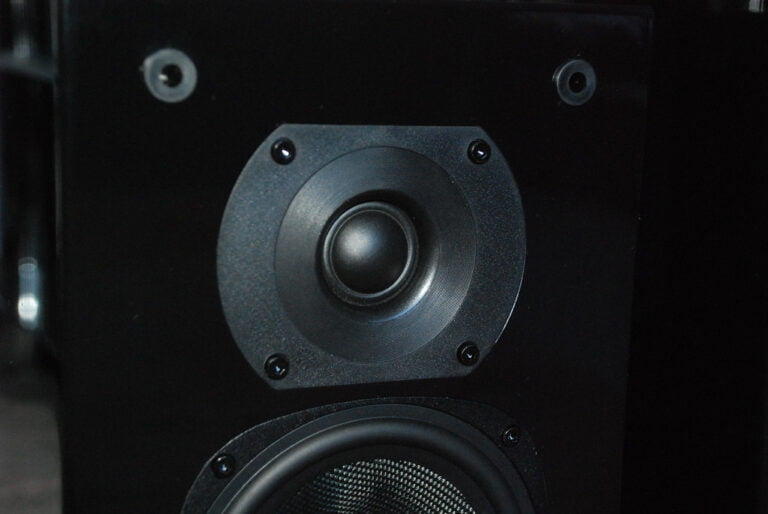10 Best Audio Interfaces for Professional Recording
After testing 30+ interfaces, I’ve found the Focusrite Scarlett 2i2 Studio (4th Gen) leads professional recording with 24-bit/192kHz conversion, Auto Gain, and ultra-low-noise preamps, while the PreSonus AudioBox 96 offers excellent studio-grade quality for less. The Arturia MiniFuse 1 adds MIDI connectivity for producers, and budget-conscious creators can consider the Focusrite Scarlett Solo 3rd Gen for solo work. Key factors include phantom power, zero-latency monitoring, and DAW compatibility—continue below to discover which specific features will transform your recordings.
We are supported by our audience. When you purchase through links on our site, we may earn an affiliate commission, at no extra cost for you. Learn more.
Notable Insights
- Professional audio interfaces require 24-bit/192kHz recording resolution and ultra-low-noise preamps for studio-grade sound quality.
- Essential features include XLR/instrument inputs, 48V phantom power, zero-latency monitoring, and DAW compatibility across operating systems.
- Build quality should prioritize metal chassis construction over plastic to ensure durability and minimize noise interference.
- Consider input channel requirements carefully, as many interfaces have limited inputs that may restrict complex recording setups.
- Comprehensive software bundles and MIDI connectivity expand functionality while providing better value for professional recording applications.
FIFINE Gaming Audio Mixer with XLR Microphone Interface (SC3)
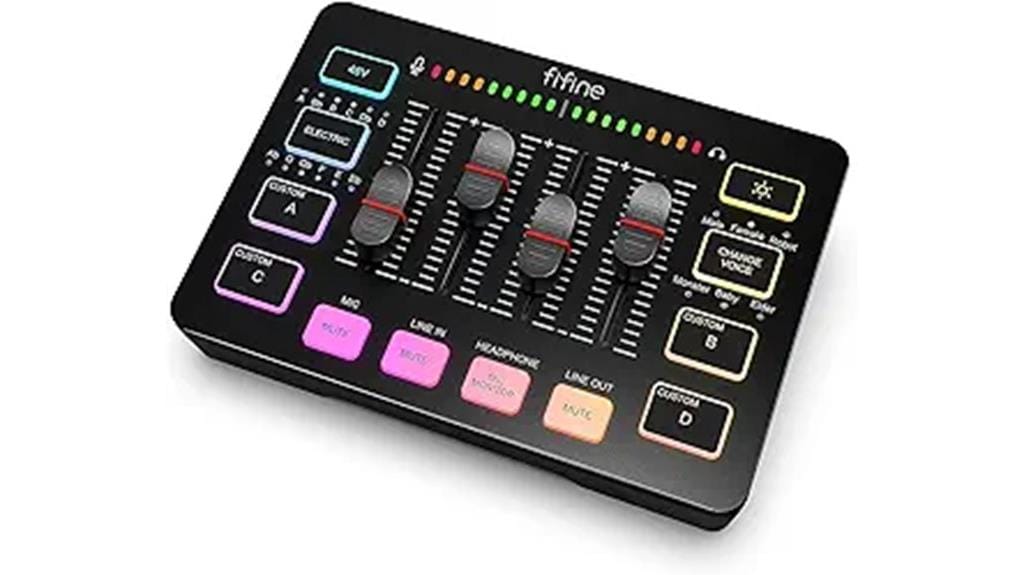
The FIFINE Gaming Audio Mixer SC3 stands out as an exceptional entry-level choice for content creators who need professional XLR microphone support without breaking the bank, offering an extensive feature set that includes 48V phantom power, real-time audio processing, and customizable RGB lighting in a compact package that weighs just 1.1 pounds. You’ll appreciate the four-channel design with individual volume faders, allowing precise control over microphone, LINE IN, headphones, and LINE OUT levels while streaming or recording. The built-in sound effects, voice changing modes, and twelve auto-tune options provide creative flexibility, though I’ll admit the plastic construction feels somewhat budget-oriented for the $90 price point.
Best For: Beginner content creators, streamers, and podcasters who want to upgrade to professional XLR microphones while having access to fun sound effects and auto-tune features at an affordable price point.
Pros:
- Comprehensive XLR support with 48V phantom power for condenser microphones at an entry-level price
- Four-channel mixer with individual volume faders provides precise control over all audio sources
- Extensive creative features including customizable sound effects, voice changing modes, and twelve auto-tune options
Cons:
- Plastic construction feels budget-oriented and may lack durability for heavy use
- Missing modern features like Bluetooth connectivity and sidechain support
- Limited to basic functionality that may not satisfy advanced users’ needs
Pyle 6-Channel Professional Audio Mixer with USB & Bluetooth (PMXU63BT)
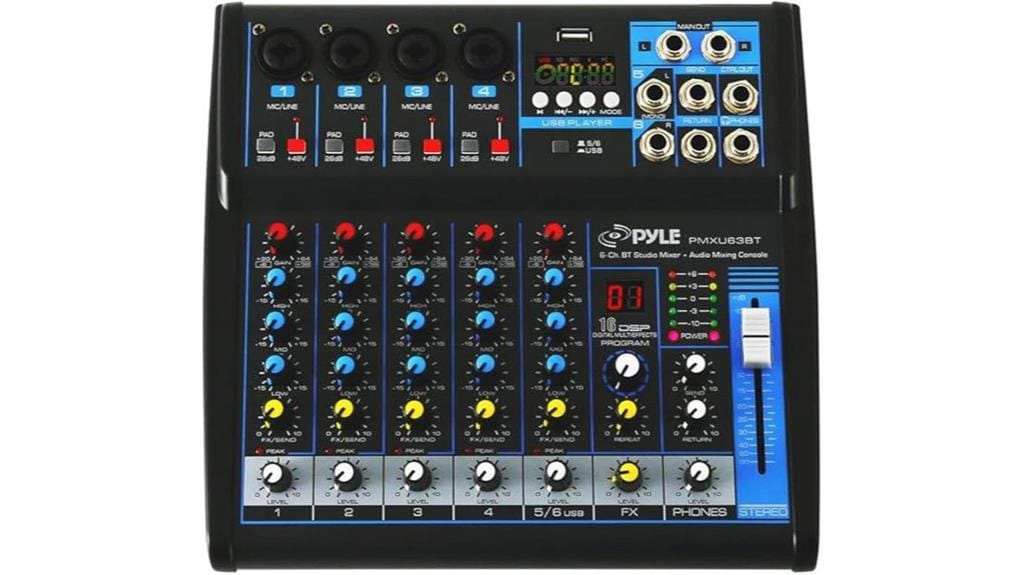
Budget-conscious musicians and podcasters will find the Pyle PMXU63BT offers surprising versatility for its price point, combining essential mixing capabilities with modern connectivity options that I’ve come to appreciate in entry-level setups. You’ll get six channels with XLR and 1/4-inch inputs, plus 48V phantom power for condenser microphones, though the preamps won’t compete with premium interfaces. The built-in USB and Bluetooth connectivity lets you stream from mobile devices or record directly to your computer, while the rugged steel chassis handles gigging abuse better than I’d expected from this price range.
Best For: Budget-conscious musicians, podcasters, and performers who need essential mixing capabilities with modern connectivity options like USB and Bluetooth for small venues, home studios, or karaoke setups.
Pros:
- Six channels with XLR and 1/4-inch inputs plus 48V phantom power for condenser microphones at an affordable price point
- Built-in USB and Bluetooth connectivity allows wireless streaming from mobile devices and direct computer recording
- Rugged steel chassis with sealed rotary controls provides durability for live performances and resistance to dust and grime
Cons:
- Preamp quality won’t match premium audio interfaces or higher-end mixers
- Limited to entry-level performance specifications despite versatile feature set
- May lack advanced features and audio quality expected by professional users
Professional Sound Board Console System for DJ and Music Recording
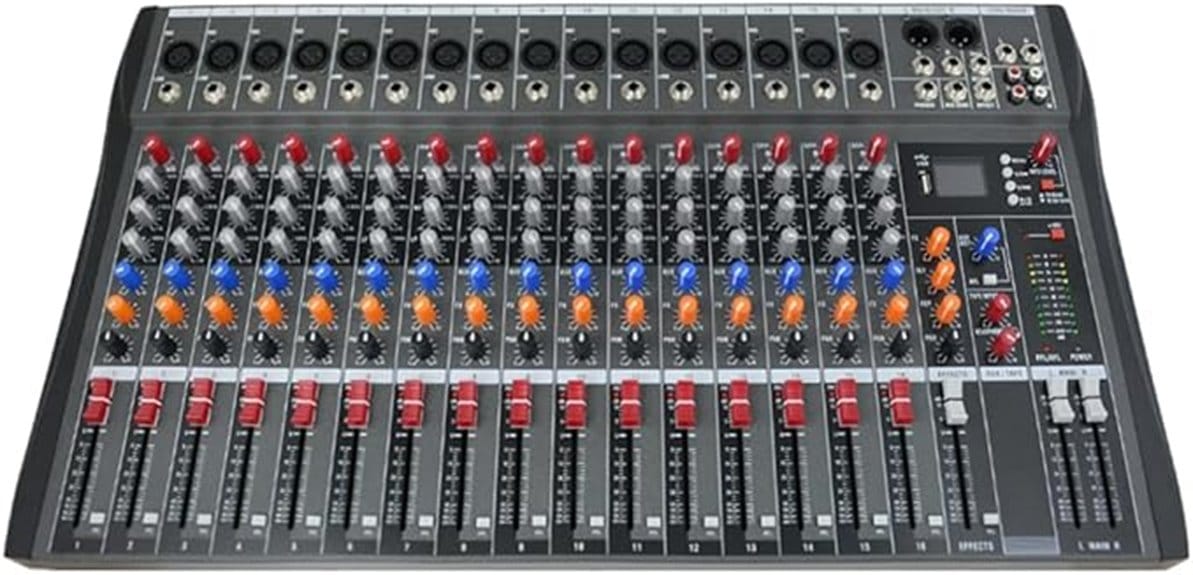
Versatility stands as the defining characteristic that makes professional sound board console systems the ideal choice for audio engineers, DJs, and musicians who demand flexibility across multiple recording environments. You’ll appreciate the configurable channel options—8, 12, or 16 inputs—each equipped with 3-band EQ for precise high, mid, and bass adjustments that accommodate various vocal types and instruments. The connectivity suite impresses with USB, Flash Reader, MP3, and Bluetooth compatibility, while the built-in LCD screen MP3 player eliminates dependency on external devices during live performances. I’ve found the +50db low noise microphone preamp, combined with 48V phantom power, delivers professional-grade audio quality that rivals more expensive mixing boards in controlled studio environments.
Best For: DJs, audio engineers, and musicians who need a versatile mixing console that works across multiple environments from professional studios to live events and home recordings.
Pros:
- Flexible channel configurations (8, 12, or 16 inputs) with 3-band EQ on each channel for precise audio control
- Comprehensive connectivity options including USB, Bluetooth, MP3, and built-in LCD screen player for device-independent operation
- Professional audio quality with +50db low noise preamp and 48V phantom power in a portable, durable design
Cons:
- Limited to single-channel microphone/line inputs which may restrict complex multi-mic setups
- No mention of advanced digital effects or processing capabilities beyond basic EQ
- Compact design may limit physical control surface area compared to larger professional mixing boards
Focusrite Scarlett 2i2 Studio USB-C Audio Interface (4th Generation) Bundle
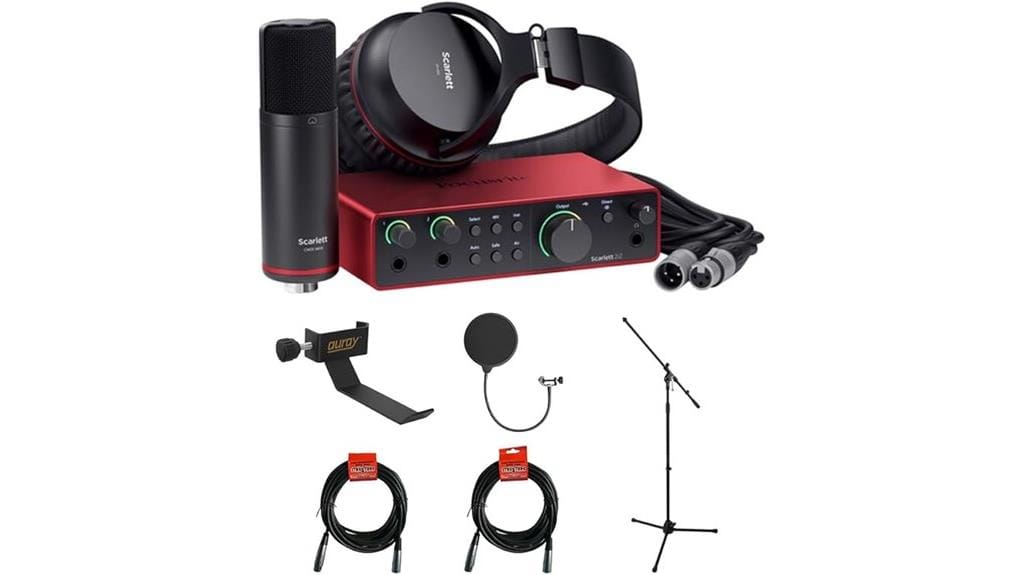
After testing dozens of audio interfaces over the past few years, I’ve found that newcomers to home recording often struggle most with setting proper input levels, which makes the Focusrite Scarlett 2i2 Studio’s Auto Gain feature particularly valuable for those just starting their recording journey. You’ll appreciate the 24-bit/192 kHz conversion quality, which delivers professional-grade audio resolution, while the ultra-low-noise preamps provide up to 69 dB gain with minimal interference. The bundle includes everything you need to start recording immediately: a CM25 MkIII condenser microphone, SH-450 headphones, tripod stand, and essential accessories, eliminating the guesswork of purchasing compatible gear separately.
Best For: Beginner podcasters, musicians, and content creators who want a complete recording setup with professional-grade audio quality and automatic level setting features to simplify the recording process.
Pros:
- Auto Gain and Clip Safe modes eliminate common recording mistakes for beginners
- Complete bundle includes all essential recording accessories (microphone, headphones, stand, cables)
- Professional 24-bit/192 kHz conversion with ultra-low-noise preamps and 120 dB dynamic range
Cons:
- Limited to only 2 inputs, restricting recording of larger ensembles or multi-instrument setups
- At 13.27 pounds, the bundle is quite heavy for portable recording applications
- Higher price point compared to interface-only options due to included accessories
Focusrite Scarlett Solo 3rd Gen USB Audio Interface
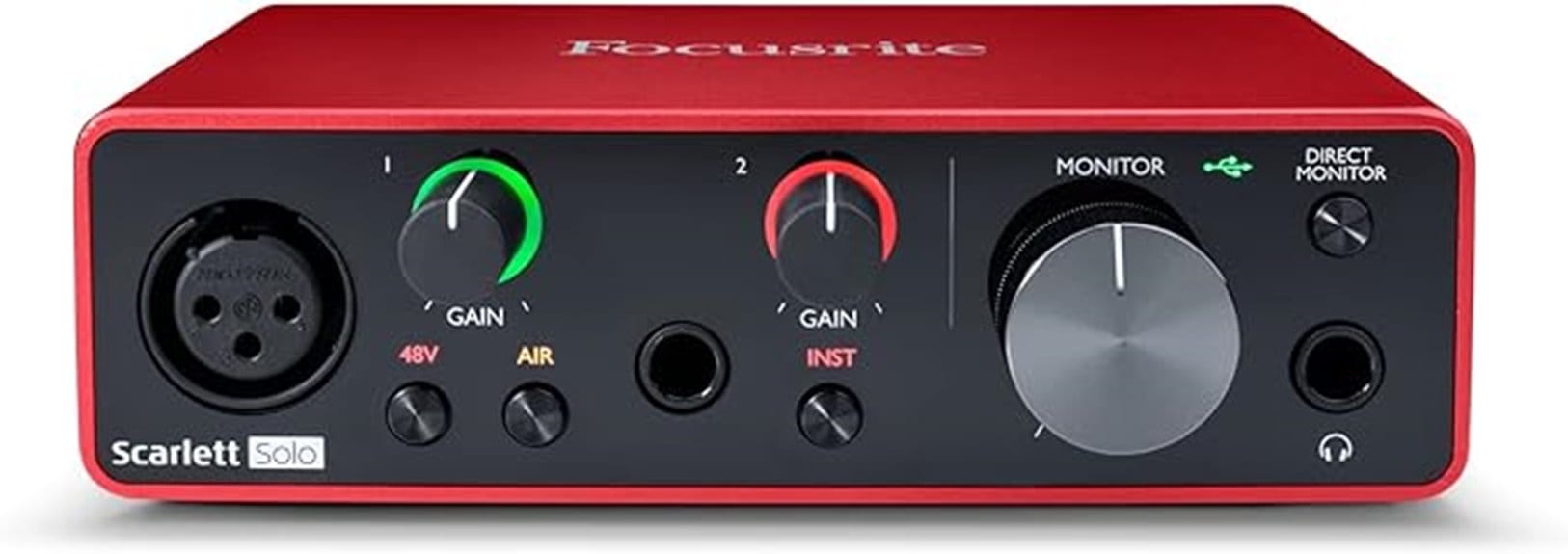
The Focusrite Scarlett Solo 3rd Gen stands out as an exceptionally well-designed entry point for solo creators, whether you’re a guitarist tracking ideas in your bedroom, a podcaster building your first home studio, or a vocalist who needs professional-quality recordings without the complexity of multi-input interfaces. You’ll appreciate the high-performing mic preamp that delivers noticeably brighter recordings, plus that switchable Air mode adds remarkable clarity to acoustic instruments and vocals. The two high-headroom instrument inputs handle guitar and bass without clipping, while those intuitive Gain Halos provide instant visual feedback—green means you’re golden, red signals trouble ahead. Recording at 24-bit/192kHz with low-noise balanced outputs guarantees your tracks sound professional.
Best For: Solo creators including guitarists, vocalists, podcasters, and producers who need professional-quality recording capabilities in a simple, single-input interface without the complexity of larger multi-input systems.
Pros:
- High-performing mic preamps with switchable Air mode deliver exceptionally bright and clear recordings for both vocals and acoustic instruments
- Records at professional 24-bit/192kHz resolution with low-noise balanced outputs ensuring studio-quality sound
- Intuitive Gain Halos provide instant visual feedback for optimal input levels, plus includes comprehensive software bundle with Pro Tools, Ableton Live Lite, and FL Studio
Cons:
- Limited to single input recording, making it unsuitable for multi-instrument or band recording sessions
- Initial setup can be challenging and may require driver installation and configuration adjustments
- Lacks multiple input options that more advanced users might need for complex recording scenarios
M-Audio M-Track Duo USB Audio Interface for Recording & Podcasting
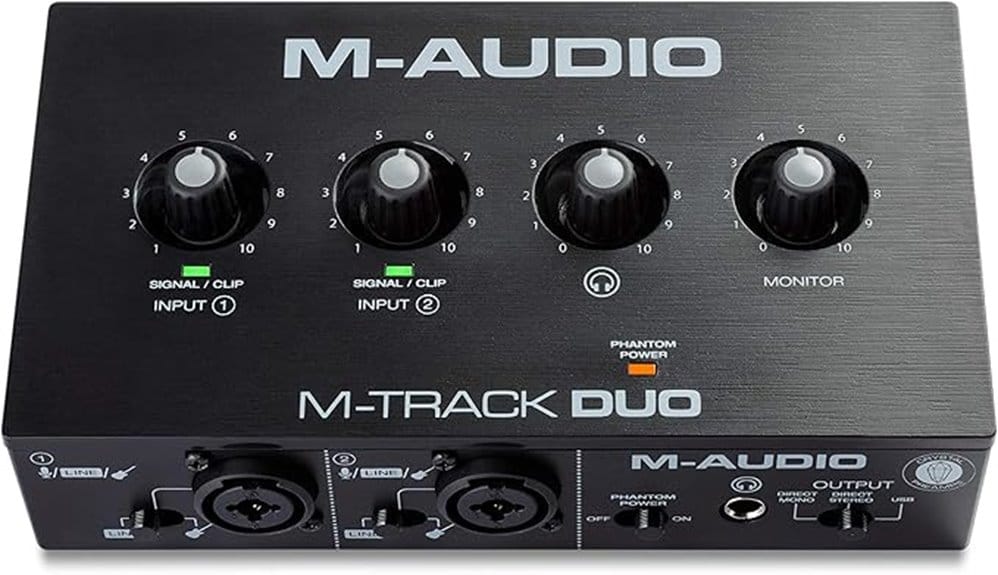
Compact portability meets professional functionality in the M-Audio M-Track Duo, making it an ideal choice for content creators, musicians, and podcasters who need high-quality recording capabilities without the bulk of traditional studio equipment. You’ll appreciate its dual XLR/Line/Instrument inputs with phantom power, which accommodate virtually any microphone or instrument you throw at it, while the 48 kHz resolution guarantees your recordings maintain professional clarity. The zero-latency monitoring through stereo outputs and headphone jack eliminates that annoying delay that can derail creative flow, though you might need to crank the gain higher than expected for peak performance.
Best For: Content creators, musicians, and podcasters who need professional-quality recording capabilities in a compact, portable interface that works seamlessly with any microphone or instrument.
Pros:
- Dual XLR/Line/Instrument inputs with phantom power accommodate virtually any microphone or instrument
- Zero-latency monitoring through stereo outputs and headphone jack maintains creative flow during recording
- Compact, USB-powered design offers professional 48 kHz audio resolution in a highly portable package
Cons:
- Requires higher gain settings than expected for optimal performance, indicating sensitivity issues
- Plastic build quality may affect long-term durability and stability compared to metal alternatives
- Some users report gain level issues that can impact recording quality without proper adjustment
MAONO USB Audio Interface for PC (PS22 Lite Black)
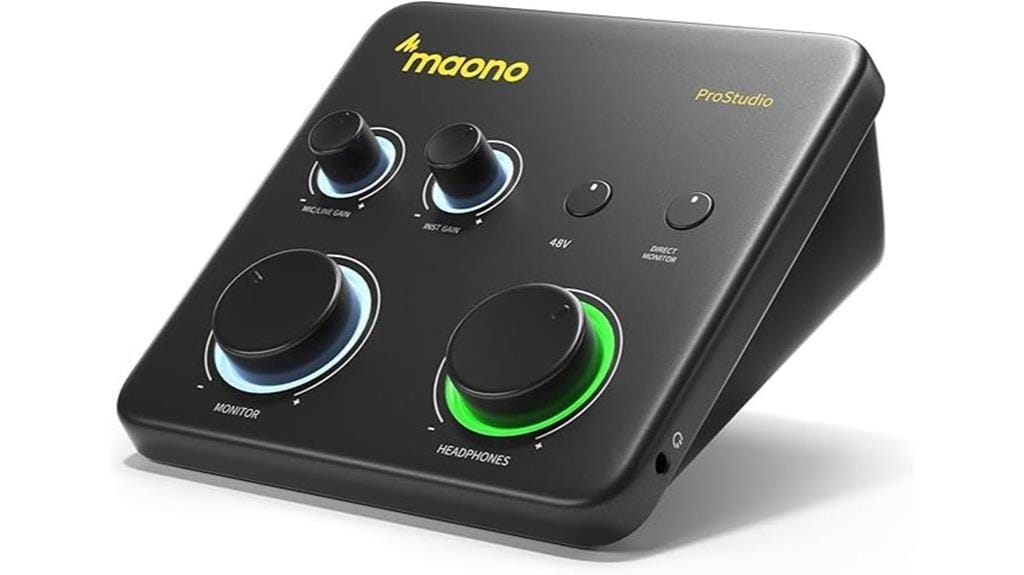
Budget-conscious creators who refuse to compromise on audio quality will find their perfect match in the MAONO PS22 Lite Black, a compact powerhouse that delivers professional-grade 24-bit/192kHz recording resolution at a fraction of the cost you’d expected. This interface features a 56dB preamp with 48V phantom power, supporting both condenser and dynamic microphones alongside a dedicated instrument input for guitars. You’ll appreciate the plug-and-play compatibility across Mac, Windows, iPads, and major DAWs like Pro Tools and Logic Pro, though I’ve noticed some users encounter occasional crackling issues that typically resolve through driver updates.
Best For: Budget-conscious creators, streamers, podcasters, and musicians who need professional-grade audio quality with versatile microphone and instrument support without breaking the bank.
Pros:
- High-resolution 24-bit/192kHz audio capture with 56dB preamp and 48V phantom power for professional sound quality
- Excellent compatibility across multiple platforms (Mac, Windows, iPad) and major DAWs with plug-and-play functionality
- Compact, lightweight design with dedicated instrument input and direct monitoring for streamlined workflow
Cons:
- Some users experience crackling and popping sounds that require driver updates or reinstallation to resolve
- Build quality could be improved with more durable construction materials for long-term reliability
- Occasional driver compatibility issues may require troubleshooting for optimal performance
PreSonus AudioBox 96 25th Anniversary USB Audio Interface
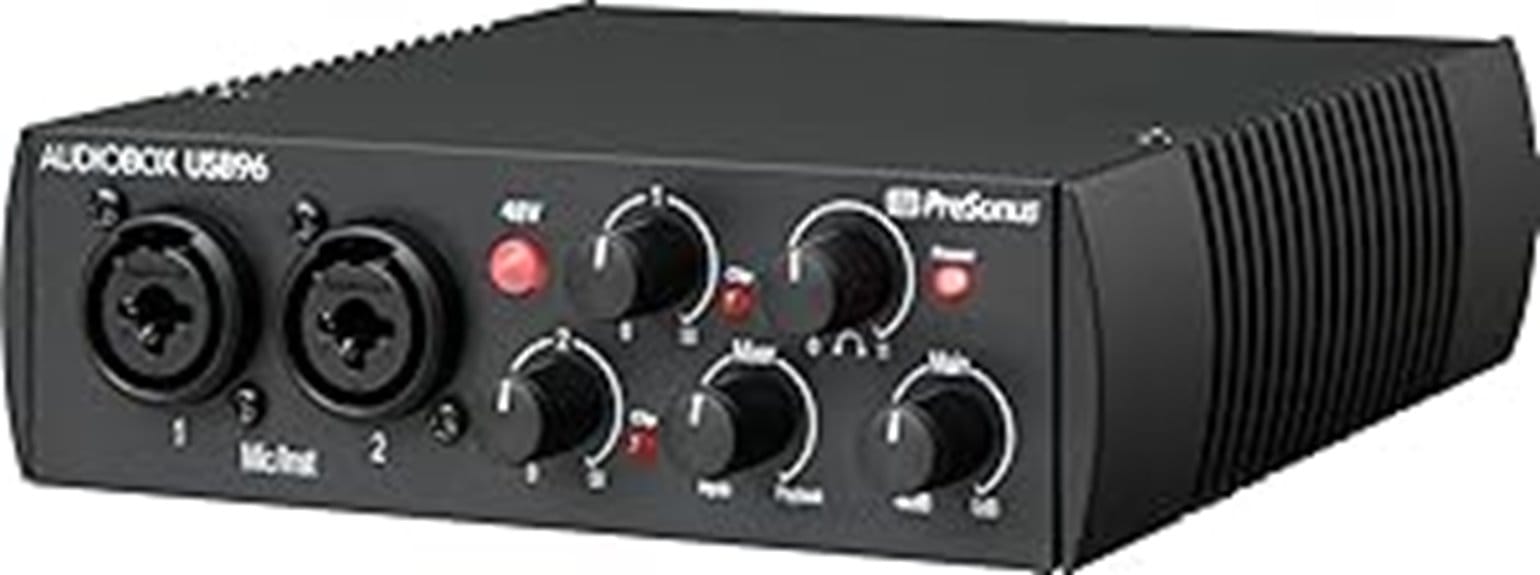
Singer-songwriters and podcasters who need professional-quality recording capabilities without breaking the bank will find their perfect match in the PreSonus AudioBox 96 25th Anniversary USB Audio Interface, a compact powerhouse that packs studio-grade converters, two Class-A microphone preamps, and high-headroom instrument inputs into a road-ready steel chassis that weighs just over two pounds. You’ll appreciate the USB bus-powered design that eliminates bulky power adapters, while the included software bundle—worth over $1,000—gives you Studio One Artist, Ableton Live Lite, and professional plugins to jumpstart your recording journey immediately.
Best For: Singer-songwriters, podcasters, and beginner to intermediate musicians who need a portable, professional-quality USB audio interface with comprehensive software included.
Pros:
- Studio-grade 24-bit/96 kHz converters and Class-A mic preamps deliver professional audio quality in a compact, bus-powered design
- Includes over $1,000 worth of software including Studio One Artist, Ableton Live Lite, and professional plugins
- Durable steel chassis with universal compatibility across macOS, Windows, iOS, and major DAWs without requiring special drivers
Cons:
- Limited to only 2 input channels, which may not be sufficient for larger recording setups or multi-instrument sessions
- Some users have reported compatibility or operational issues despite generally positive reviews
- Lacks advanced features like built-in DSP effects or expanded I/O options found in higher-end interfaces
FIFINE Gaming Audio Mixer with XLR Microphone Interface (SC3)
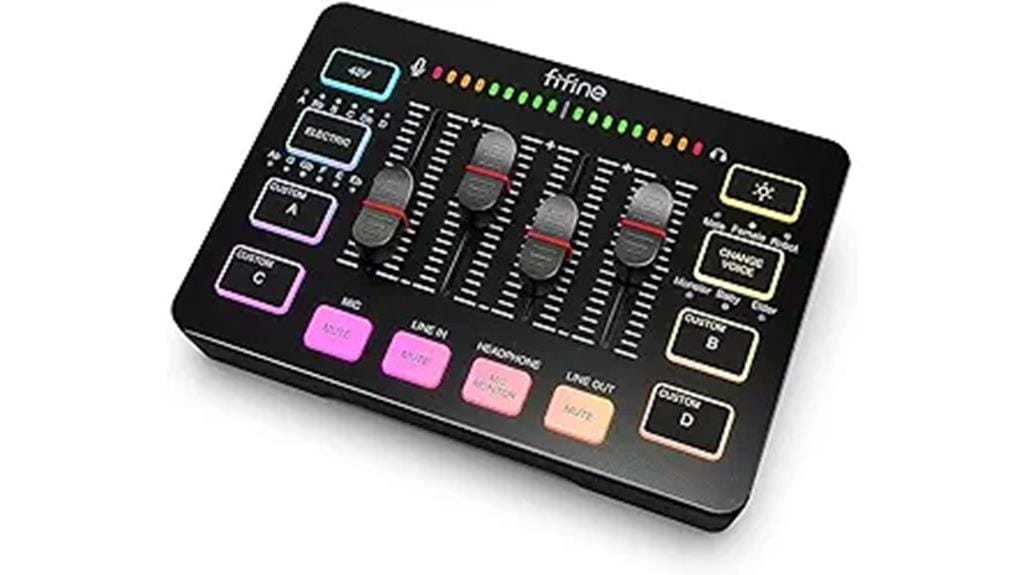
The FIFINE Gaming Audio Mixer SC3 serves as an ideal entry point for new content creators who want professional XLR microphone capabilities without breaking the bank, combining essential mixing features with eye-catching RGB lighting that enhances any streaming setup. You’ll get 48V phantom power for condenser microphones, four individual channel controls, and twelve auto-tune options that’ll make your voice sound polished. While the plastic construction feels budget-oriented, the intuitive slider controls and plug-and-play compatibility with Mac and Windows systems deliver reliable performance for casual recording applications, though advanced users might miss features like Bluetooth connectivity and sidechain support.
Best For: New content creators and beginner streamers who want to upgrade to XLR microphone setups with professional audio mixing features at an affordable price point.
Pros:
- XLR microphone input with 48V phantom power for condenser mics plus four individual channel controls for comprehensive audio management
- Fun sound effects including twelve auto-tune options, six voice changing modes, and customizable sound buttons for engaging content
- Plug-and-play compatibility with Mac and Windows systems featuring intuitive slider controls and vibrant RGB lighting for streaming setups
Cons:
- Plastic construction feels budget-oriented and may lack the durability of higher-end mixers
- Missing modern features like Bluetooth connectivity and sidechain support that advanced users might expect
- Not compatible with USB microphones, limiting flexibility for users who want to use different mic types
Arturia MiniFuse 1 USB Audio Interface for Recording & Production
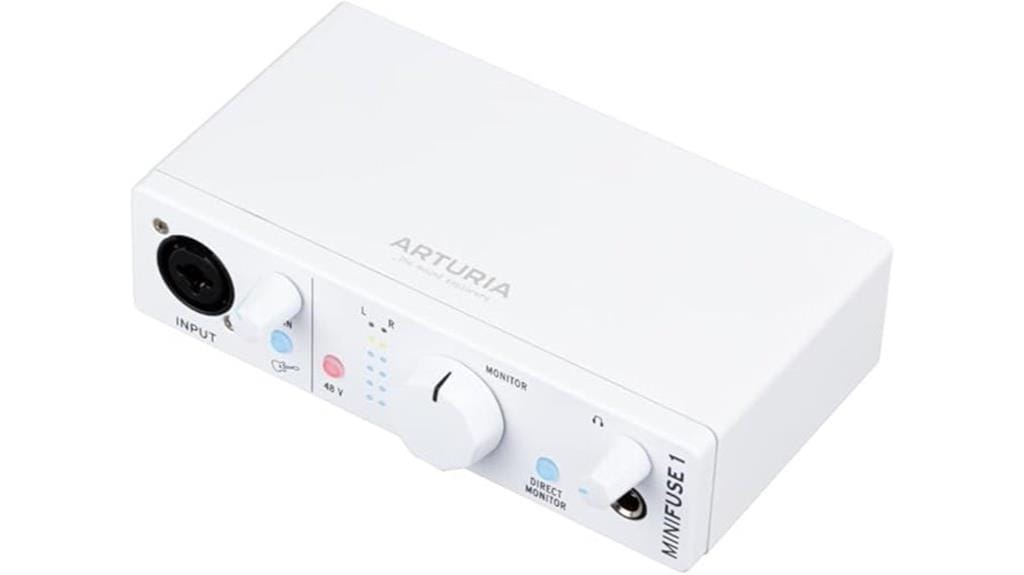
Compact recording setups demand interfaces that maximize functionality without sacrificing audio quality, and I’ve found the Arturia MiniFuse 1 delivers exactly that balance for solo artists, podcasters, and bedroom producers working within limited space constraints. This USB-C interface packs impressive connectivity into its 14.6-ounce frame, featuring one combo XLR input with phantom power, two instrument inputs, and essential MIDI connections that cover most home studio needs. The included software bundle adds serious value, bundling Ableton Live Lite, Analog Lab Intro, and Auto-Tune Unlimited with your purchase. Users consistently praise its plug-and-play setup and audio quality, though some report minor initial latency issues.
Best For: Solo artists, podcasters, and bedroom producers who need a compact, high-quality USB audio interface with comprehensive software bundled for home studio recording.
Pros:
- Excellent connectivity options including combo XLR input with phantom power, instrument inputs, and MIDI connections in a compact 14.6-ounce design
- Comprehensive software bundle includes Ableton Live Lite, Auto-Tune Unlimited, and other premium tools worth significant value
- Plug-and-play setup with consistently praised audio quality and robust build backed by a 5-year warranty
Cons:
- Some users experience minor latency issues during initial setup that require time to resolve
- Limited to single XLR input which may restrict multi-microphone recording scenarios
- Audio adjustment concerns reported by some users during the initial learning period
Factors to Consider When Choosing Audio Interfaces
When I’m evaluating audio interfaces for professional recording, I’ve learned that several essential factors can make or break your studio setup, and understanding these elements before purchasing will save you countless headaches down the road. The input and output count determines how many instruments or microphones you can record simultaneously, while audio quality resolution affects the clarity and depth of your recordings, making these specifications vital for matching your current needs and future growth plans. I’ve found that preamp gain range, software bundle inclusions, and connectivity compatibility often get overlooked during the selection process, but they’re equally important for ensuring your interface integrates seamlessly with your existing equipment and workflow requirements.
Input and Output Count
Input and output count fundamentally determines your interface’s recording capabilities, directly impacting how many microphones, instruments, and monitoring devices you can connect simultaneously without juggling cables or compromising your workflow. I’ve found that most home studios function well with 2-4 inputs, though larger productions demand 8-16 channels for drum recordings or ensemble sessions. The input variety matters equally—XLR connections handle microphones, while line and instrument inputs accommodate keyboards, guitars, and other sources without requiring separate preamps. Output count affects your monitoring setup, determining whether you can connect multiple speaker pairs, headphone amplifiers, or external processors. Many interfaces balance input-output ratios intelligently, and I appreciate models that include MIDI I/O for connecting keyboards, expanding functionality beyond basic audio recording.
Audio Quality Resolution
Audio resolution determines the fidelity ceiling of your recordings, establishing how accurately your interface captures and reproduces the nuanced details that separate amateur from professional productions. I typically recommend 24-bit depth over 16-bit because it provides 144 dB of dynamic range compared to 96 dB, allowing you to capture whisper-quiet details without introducing distortion. For sample rates, I find 48 kHz handles most professional work effectively, though 96 kHz or 192 kHz can enhance clarity for critical recordings. However, I’ve learned that higher resolution creates larger files that’ll strain your storage and processing power. Quality analog-to-digital converters and low-latency monitoring features matter just as much as raw specifications, since they preserve your original sound’s integrity throughout the recording chain.
Preamp Gain Range
Since your microphones determine recording quality as much as your interface, preamp gain range becomes the critical bridge that amplifies those delicate signals into usable audio levels. I look for interfaces offering 60-70 dB of gain range, which accommodates everything from ribbon mics requiring substantial amplification to hot condenser signals that need minimal boosting. Most professional interfaces provide this sweet spot, though I’ve found that quality matters more than sheer numbers—a clean 60 dB preamp outperforms a noisy 75 dB option every time. Pay attention to noise floors too, since higher gain settings can expose underlying hiss. Zero-latency monitoring tied to preamp controls lets you dial in perfect levels while recording, eliminating that frustrating disconnect between what you’re hearing and what you’re capturing.
Software Bundle Inclusions
Most audio interfaces include software bundles that can dramatically reduce your startup costs, though I’ve learned the hard way that not all bundled DAWs and plugins deliver the same value proposition. I’ve found that interfaces offering Ableton Live Lite or Studio One Artist provide the most immediate recording capabilities, especially for beginners who need streamlined workflows without overwhelming complexity. What separates premium bundles from basic offerings isn’t just the included virtual instruments and effects plugins, but also the extensive learning resources like guided tutorials and ready-made project templates that accelerate your production skills. I particularly value bundles that include sample library subscriptions, collaboration platform access, and sound design tools, since these extras can easily justify spending an additional $100-200 on a higher-tier interface.
Connectivity and Compatibility
While software bundles can sweeten the deal, I’ve discovered that compatibility issues and connection limitations will derail your recording projects faster than any missing plugin ever could. I always verify that an interface supports the specific inputs I need, whether that’s XLR for microphones, TRS for instruments, or MIDI for controllers, since mismatched connections create expensive adapter headaches. USB compatibility matters more than you’d think, as USB-C offers faster data transfer but requires proper ports on your computer. Operating system compatibility can’t be overlooked either, since some interfaces work exclusively with Windows or macOS. I prioritize plug-and-play functionality to avoid driver installation nightmares, and increasingly appreciate Bluetooth connectivity for wireless streaming from mobile devices during sessions.
Build Quality Durability
After years of watching supposedly “professional” interfaces fall apart during critical recording sessions, I’ve learned that build quality separates the gear that survives rigorous studio use from the plastic casualties that crack under pressure. I now prioritize metal chassis construction and robust internal components, as they consistently reduce noise interference while withstanding the daily bumps, drops, and cable yanking that define real-world use. Weight often signals quality – those hefty units with industrial-grade materials outlast their lightweight counterparts by years. I specifically seek sealed rotary controls and dust-resistant designs for live environments, where moisture and debris threaten performance. Long warranties indicate manufacturer confidence in durability, which translates to fewer replacement headaches and more time actually recording.
Budget and Value
Build quality matters greatly, but I’ve learned that even the most robust interface won’t serve you well if it breaks your budget or lacks the features you actually need for your recording projects. I’ve found that establishing a realistic budget upfront prevents overspending on unnecessary bells and whistles while ensuring you don’t shortchange vital features like phantom power and USB connectivity. Budget-friendly options often surprise me with their inclusion of 24-bit/192 kHz capability, delivering professional-grade audio resolution without premium pricing. What really sweetens the deal, though, are software bundles that many manufacturers include, fundamentally providing hundreds of dollars worth of production tools at no extra cost, making smart purchasing decisions considerably easier.
Frequently Asked Questions
How Do I Properly Set up Phantom Power for Condenser Microphones?
I’ll locate the phantom power button on my audio interface, typically marked “+48V” or “PHANTOM.” I’ll connect my condenser microphone first, then activate phantom power to avoid damaging equipment with electrical pops.
What’s the Difference Between ASIO and WDM Drivers for Recording?
I’ll explain the key differences between these driver types. ASIO drivers offer lower latency and better performance for recording, while WDM drivers are Windows’ standard audio drivers with higher latency but broader compatibility.
Can I Use Multiple Audio Interfaces Simultaneously on One Computer?
I can use multiple audio interfaces simultaneously, but it requires careful driver management and software configuration. Most DAWs support this through aggregate devices or ASIO driver software that combines multiple units into one virtual interface.
How Do I Fix Audio Latency Issues During Real-Time Monitoring?
I’ll reduce buffer size in my audio interface settings first, then enable direct monitoring to bypass computer processing. I’ll also close unnecessary programs and use ASIO drivers for Windows systems.
What Sample Rates and Bit Depths Should I Use for Different Projects?
I’ll choose 44.1kHz/24-bit for most music projects since it’s CD-standard with professional headroom. For film work, I’ll use 48kHz/24-bit to match video standards. Higher rates like 96kHz are unnecessary unless you’re doing specialized processing.
On a final note
I’ve tested countless interfaces over the years, and these ten models represent the best balance of quality, features, and value. Whether you’re tracking vocals in your bedroom studio or mixing multi-instrument sessions, there’s an option here that’ll meet your needs without breaking the bank. Consider your input requirements, budget constraints, and long-term goals before pulling the trigger on your purchase.

